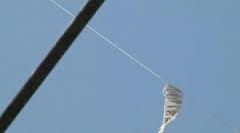A Wire Runs Through It

David W. Stowe
This week Yale unveiled an intriguing three-sited exhibition on the Jewish eruv. What is an eruv, you ask? “An eruv is a partnership created within a boundary to enhance the observance of the Jewish Sabbath,” explains the website of Yale’s Initiative for the Study of Material & Visual Cultures of Religion (MAVCOR).
This week Yale unveiled an intriguing three-sited exhibition on the Jewish eruv. What is an eruv, you ask? “An eruv is a partnership created within a boundary to enhance the observance of the Jewish Sabbath,” explains the website of Yale’s Initiative for the Study of Material & Visual Cultures of Religion (MAVCOR).
“Rabbinic law, enunciated in the
Talmud, interprets the biblical imperative to ‘do no work’ on the Sabbath as
forbidding the carrying of objects from a private space into a public space on
that day. Because, however, the injunction against carrying would seem to
contravene the biblical command that the Sabbath be ‘a joy,’ the rabbinical
corpus characteristically mediated between strictures and joy by instituting
the eruv. During Shabbat, the eruv border operates to transform a community
into a shared dwelling place. In practice, the eruv allows an orthodox Jew to
carry prayer books to the synagogue, to push strollers and wheelchairs, and to
allow children to play outside.”
As befits an exhibition concerned with the extension and
delimiting of social space, the exhibition sprawls across New Haven. Up
on Divinity Hill, the ISM Gallery of Sacred Arts includes photographs
and artworks in a variety of media, including an installation Kafka in Space
(Parsing the Eruv) which, according to curator Margaret Olin, “brings out
the dystopic notion of the eruv suggested in Kafka’s aphorism on which the
piece is based: ‘The true path leads across a rope that is no suspended on
high, but close to the ground. It seems more intended to make people stumble
than to be walked upon.’ When read with Kafka’s comment on the Warsaw eruv
quoted in the [catalog’s] introduction, it suggests a society made up of
unwieldy rules that are, for lack of a better word, Kafkaesque.”
Downtown, the Joseph Slitka Center for Jewish Life is
running an exhibit of photographs organized under the title Israel: Gated
Community, while the School of Art’s Edgewood Gallery features installations
that “move beyond the metaphor of the eruv to explore the consequences of the
notion of borders for interpersonal relations.”
There are some interesting uses of video technology,
including a laser-based eruv of the future that signals when the eruv is “up”
through a telltale pattern on the monitor, and a double-projection video
installation called Turbulent: “While on one screen a male singer sings
a lovely ballad to a crowded hall where male listeners fill every seat, on the
opposite screen a woman faces an empty auditorium,” Olin describes. “As he
finishes his love song and takes his bow, however, the singer is distracted by
unearthly sounds, an ecstatic wordless music coming from the woman on the other
screen. He stands, spellbound and silenced by her raw emotion, while the viewer
is transfixed between the two.”
“The eruv boundary would appear to be an almost ideal
border,” the MAVCOR site explains. “It
is marked so subtly that it is almost invisible: by redefining already existing
utility wires with the addition of common pieces of hardware or fishing line.
No one who does not wish to needs to observe its limitations. Yet the
institution of an eruv demands the cooperation of surrounding non-Jewish
communities and is often the center of acrimonious disputes, including, for
example, litigation currently in process nearby in the Hamptons, famous
disputes in London, and competing eruv-installations in Brooklyn and in
Jerusalem, where vandalism sometimes occurs. The concept of the eruv raises
issues about public and private spaces, about borders and limitations and the
communities they encompass that speak, in multifold and fascinating ways, to
wider concerns about nations, immigration, property, and human rights.

Comments